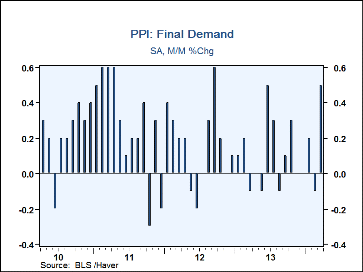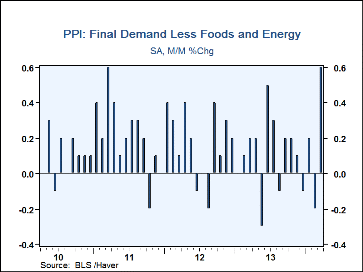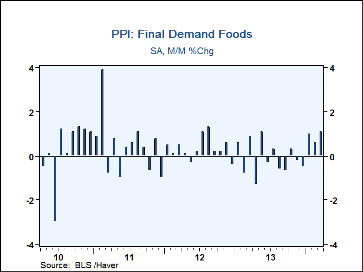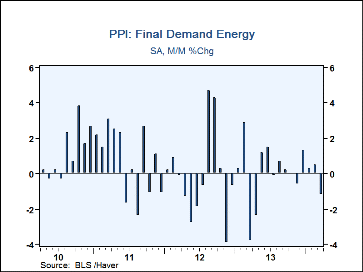 Global| Apr 11 2014
Global| Apr 11 2014U.S. Producer Price Index Strengthens as Service Prices Jump
by:Tom Moeller
|in:Economy in Brief
Summary
The overall final demand PPI increased 0.5% (1.4% y/y) in March following an unrevised 0.1% February slip. It was the largest increase in twelve months and easily beat expectations for a 0.1% uptick in the Action Economics Forecast [...]
The overall final demand PPI increased 0.5% (1.4% y/y) in March following an unrevised 0.1% February slip. It was the largest increase in twelve months and easily beat expectations for a 0.1% uptick in the Action Economics Forecast Survey. Producer prices excluding food & energy jumped 0.6% (1.4 y/y), beating the expected 0.2% gain.
Final demand prices for services (63% of the total) provided the lift to last month's overall PPI gain with a 0.7% rise (1.6% y/y). Prices for transportation of passengers gained 2.0% (0.2% y/y) following declines in three of the prior four months. That increase was partially offset by a 0.1% slip (+1.3% y/y) in transportation of goods.
Final demand prices for goods (35% of the total) were unchanged (1.1% y/y) following three consecutive months of 0.4% increase. Consumer food prices increased 0.7% (1.9% y/y) but consumer demand prices for energy goods dropped 1.0% (+1.6% y/y). Finished consumer goods prices excluding food & energy ticked 0.1% higher (2.1% y/y). Private capital equipment prices were unchanged (1.2% y/y) as were export goods prices (0.4% y/y). Final demand prices for construction also were unchanged (3.2% y/y).
Prices for intermediate demand of processed goods fell 0.2% (+0.7% y/y).
Measured using the old formula, which is being phased out as the headline series, producer prices slipped 0.1% (+1.7% y/y) after a 0.4% February gain. Food costs rose 0.7% (2.0% y/y) while energy prices declined 1.0% (+1.7% y/y). Prices excluding food & energy ticked up 0.1% (1.7% y/y) for the second consecutive month.
The PPI data are contained in Haver's USECON database with further detail in PPI and PPIR. The expectations figure is available in the AS1REPNA database.
| Producer Price Index (%) | Mar | Feb | Jan | Mar Y/Y | 2013 | 2012 | 2011 |
|---|---|---|---|---|---|---|---|
| Final Demand | 0.5 | -0.1 | 0.2 | 1.4 | 1.3 | 1.9 | 3.9 |
| Excluding Food & Energy | 0.6 | -0.2 | 0.2 | 1.4 | 1.5 | 1.9 | -- |
| Goods | 0.0 | 0.4 | 0.4 | 1.1 | 0.8 | 1.7 | 6.8 |
| Foods | 1.1 | 0.6 | 1.0 | 0.8 | 1.6 | 3.0 | 8.5 |
| Energy | -1.2 | 0.5 | 0.3 | 1.0 | -0.8 | 0.2 | 17.5 |
| Goods Excluding Food & Energy | 0.1 | 0.2 | 0.4 | 1.2 | 1.1 | 1.8 | 3.4 |
| Services | 0.7 | -0.3 | 0.1 | 1.6 | 1.6 | 1.9 | 2.1 |
| Construction | 0.0 | 0.1 | 0.6 | 3.2 | 1.8 | 2.9 | 2.2 |
| Intermediate Demand - Processed Goods | -0.2 | 0.7 | 0.6 | 0.7 | 0.0 | 0.5 | 8.9 |
Tom Moeller
AuthorMore in Author Profile »Prior to joining Haver Analytics in 2000, Mr. Moeller worked as the Economist at Chancellor Capital Management from 1985 to 1999. There, he developed comprehensive economic forecasts and interpreted economic data for equity and fixed income portfolio managers. Also at Chancellor, Mr. Moeller worked as an equity analyst and was responsible for researching and rating companies in the economically sensitive automobile and housing industries for investment in Chancellor’s equity portfolio. Prior to joining Chancellor, Mr. Moeller was an Economist at Citibank from 1979 to 1984. He also analyzed pricing behavior in the metals industry for the Council on Wage and Price Stability in Washington, D.C. In 1999, Mr. Moeller received the award for most accurate forecast from the Forecasters' Club of New York. From 1990 to 1992 he was President of the New York Association for Business Economists. Mr. Moeller earned an M.B.A. in Finance from Fordham University, where he graduated in 1987. He holds a Bachelor of Arts in Economics from George Washington University.










